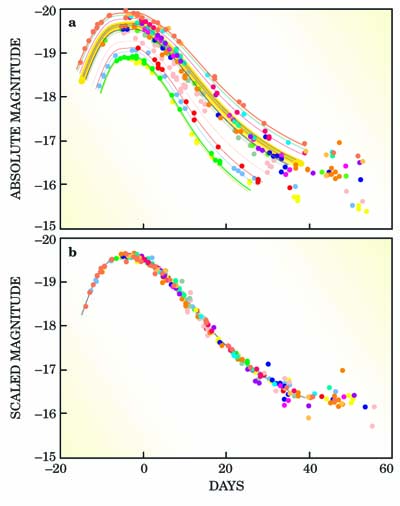High-Z Supernova Search
Table of ContentsThe Expanding Universe
The Fate of the Universe
Supernovae
Type Ia Supernovae [1] [2] [3]
Searching for Distant Type Ia Supernovae
Search Results
Search Conclusions
Type Ia Supernovae
Type Ia Supernovae are not all exactly the same brightness. They vary by as much as a factor of two. But Mark Phillips, Mario Hamuy and collaborators at Cerro Tololo Inter- American Observatory in Chile showed that fainter supernovae rise and fall very quickly, whereas the brighter supernova ridse and fade in brightness much more slowly. By looking at how much the objects faded in the first 15 days following maximum light, they were able to show that type Ia supernovae can give distances which are good to about 7% - thus yeilding a precison that is equal to the best astronomical distance indicators.
Light curves of nearby, low-redshift type Ia supernovae measured by Mario Hamuy and coworkers.
(a) Absolute magnitude, an inverse logarithmic measure of intrinsic brightness, is plotted against time (in the star's rest frame) before and after peak brightness. The great majority (not all of them shown) fall neatly onto the yellow band. The figure emphasizes the relatively rare outliers whose peak brightness or duration differs noticeably from the norm. The nesting of the light curves suggests that one can deduce the intrinsic brightness of an outlier from its time scale. The brightest supernovae wax and wane more slowly than the faintest.
(b) Simply by stretching the time scales of individual light curves to fit the norm, and then scaling the brightness by an amount determined by the required time stretch, one gets all the type Ia light curves to match.
Source: Saul Permutter, Physics Today, April 2003, pp 54-49

